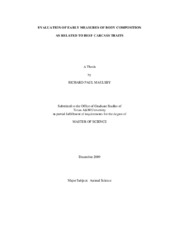| dc.description.abstract | Two similarly managed trials were conducted to investigate serial ultrasound
measures of body composition (longissimus muscle area (ULMA), 12th - rib fat
thickness (UFAT), and percentage of intramuscular fat (UIMF)) early in the lives of
feeder calves as they compared to carcass traits. Group 1 cattle were Charolais-sired by
Brahman-British crossbred dams whereas Group 2 cattle were purebred Beefmaster.
Both groups were fed at the same commercial feedlot (Graham Land and Cattle Co.) in
Gonzales, Texas. In both data sets classifications were developed for ribeye area of
Lower (less than 70.95 cm2, Middle (between 70.95 cm2 and 90.3 cm2) and Upper (over
90.3 cm2) based on a range that fit within the ribeye specifications of such branded beef
programs as Certified Angus Beef and Nolan Ryan?s Tender Aged Beef. Differences
among ribeye area and quality grade (Choice vs. Select) categories were evaluated for
ultrasound and carcass traits. As reported previously, correlations between ultrasound
measures and carcass traits became larger at times closer to harvest. In both sets of
cattle, there were no differences in fat thickness or intramuscular fat at the ultrasound
scan sessions or in these carcass traits due to ribeye area category. The same trend for quality grade classification was not seen across both groups of cattle however. In Group
1, there were no differences in early measures of body composition between carcass
quality grade classes except for ultrasound fat thickness at weaning. However, in Group
2 cattle there were differences in ultrasound fat at times 1 and 2, IMF at time 1, and
ribeye area at time 2 between cattle that graded choice verses those that graded select.
Correlations between ultrasound measures of REA (r of .26 to .50) and ultrasound REA
and carcass REA (r of .16 to .81) appeared to be lower in Group 1 vs. Group 2 (r of .55,
and .64 to 81 respectively). Results from this project imply that changes in ribeye area
will not automatically result in changes of marbling and vice versa. Furthermore, these
results also show that ultrasound is useful to help predict beef carcass traits, but that
early measures of body composition used alone do not explain a large portion of the
variation in the carcass measures and specific methods should be developed by different
biological cattle types. | en |


